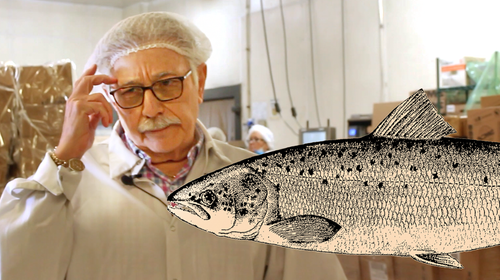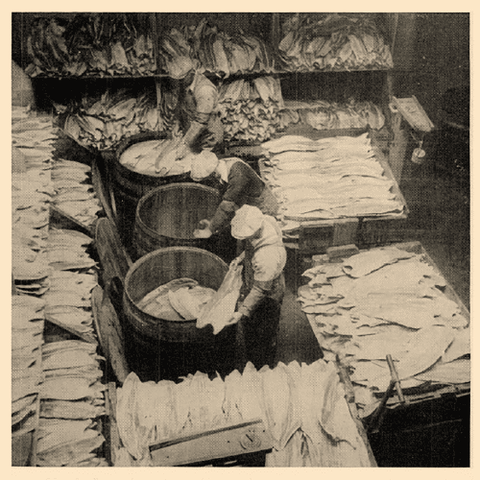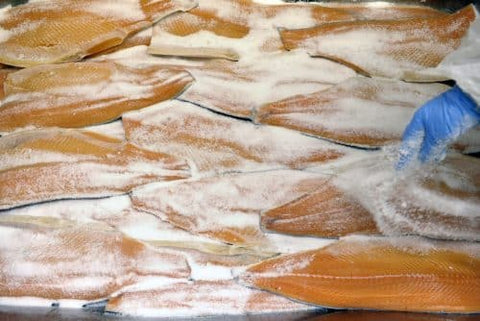BACK
What Is Nova Smoked Salmon?
By: Acme Smoked Fish

What is nova?
To some, it’s a state of mind. It’s the top-of-the-line smoked salmon; hand sliced and crafted. Others have never heard of the word, and if they have, are hard pressed to provide a proper definition.
We decided to ask our friends and experts at Acme the inexplicable question, “What is nova?” Join our team in a lesson of smoked fish lexicon to find out the true meaning of nova.
Watch the video above or read the transcript of the interview below.
This interview transcript has been edited for length and clarity.
My name is Mitchell Gardner. I’ve worked at Acme for 17 years and I am a senior sales manager.

Okay. So, what is Nova…. Many years ago before the second world war, the only lox that people ate was what we call belly lox today. It was wild king salmon that was caught fresh and salt cured, put in large barrels to cure and ferment for about 90 days before it was ready to use.
In those barrels, it was shipped East, where smokers back in Brooklyn, New York put it in cold storage for as much as a year, a year and a half, until they were ready to use it. They would then bring the barrels into their building, take out the amount of salmon that they needed for that day, and then soak it in cold water to remove some of the salt and make it palatable.
Then they would hang the fish by its collar in a room where they would apply smoke. So, in those days it was simply salt cured salmon with smoke. There was no Nova Scotia salmon, per se. During World War II, there was an extreme shortage of king salmon, which is what they predominantly used in our industry. In order to have product some of the smokers in New York looked toward Nova Scotia, where every year there was a run of wild Atlantic salmon. This is the same salmon that today is farm raised worldwide, but these were wild salmon that were caught and frozen.
So, the following story was told to me about my father who was in the smoked fish business as well…. I must have been seven or eight years old, which means I’m going back 69 to 70 years… He told me that during the war, when salmon was hard to get, the smokers brought in salmon from Nova Scotia, which was frozen and not fresh, and tried to find a way to cure it so that their clientele would be comfortable with what they were eating.
First, they tried simply salt curing it, which is what they were used to in the previous fresh salmon run. They found that because the fish had been frozen, it didn’t accept the cure in the same manner. So then someone got the idea, ‘Well, you know what, we need salt to preserve the fish, but we don’t want it to be too salty. Let’s put in sugar to counteract the taste of the salt.’
During the second world war white sugar was rationed, so they went and used brown sugar, which was easily attainable. For many, many years the formula to make Nova Scotia salmon included salt and brown sugar. Once they developed the process, which was brining the fish for five to seven days in salt and brown sugar, they would lay the fish out on screens and put it into a room to be dried and then smoked with hardwood smoke.

The subject came up… ‘What do we call this?’ Well, since the fish at that time came from producers in Nova Scotia, they said, ‘We will call it Nova Scotia salmon.’ And that’s how it was for many years. I remember growing up in my father’s [smoked fish] retail store, people would come in and they’d say, ‘Give me a quarter pound of Nova Scotia lox, or a half a pound of Nova Scotia lox.” Over the course of the last 70 years or so, the two words Nova Scotia, they kind of dropped the Scotia portion of it and it wound up being Nova. Today, it’s really nothing more than a curing process, but the word Nova has stuck.
Over the course of years the product made its way from the bagel shop and the delicatessen into supermarkets, and from the deli department in supermarkets it transitioned to the seafood department. Now Nova has been opened up to a whole world of different people and everybody is enjoying the product.
So, the difference between lox and Nova is that, to this very day, lox is made from fresh salmon that is only salt cured. The salmon is fileted, it’s put into kosher salt, put into a tub, and covered with a 100% salt brine solution. In this process, the fish has to stay for about 90 days before it reaches its potential to be eaten with the texture that we would like. Salty lox, or regular lox, or belly lox – all three names have been used – is nothing more than salt cured salmon. It is not smoked.
The difference now with Nova salmon is that it is salt cured. Today, we have taken the sugar out of the process, and we just use salt, following all the governmental regulations. It’s cured anywhere from 18 to 24 hours. The fish are then rinsed off, put into a smoker anywhere between 72 and 78 degrees, where it’s dried for a period of seven to 12 hours. The ovens that the fish are dried in remove the moisture. And then, at a certain point, when the fish reaches a certain dryness, smoke is applied for anywhere from two hours to eight hours, depending on the flavor profile we’re looking for.

Nova is smoked. Yes. The difference between lox and Nova is that Nova is dried and then smoked. The meat has a little bit of a different texture and flavor.
No, not at all.
You would be hard pressed to find any kind of Nova in Nova Scotia. It’s just not there.

Because it’s an American thing. They have smoked salmon in Canada, but the Atlantic salmon that for hundreds of years ran wild up the Atlantic seaboard to Canada, that run of fish no longer exists. I don’t know what happened to it. I just know that it doesn’t exist today. Of course, we can get the same [Atlantic] salmon farmed, and I happen to think that farmed salmon for smoking is absolutely wonderful.
Yeah. Listen, historically, there were a lot of things that were born out of necessity. I mean, one of the earliest ways of curing fish going back… we can go back a thousand years. I mean, people would take fish, and they found that if they buried it by the ocean and left it there the salmon would cure just from the salt in the water.
You know, I want our customers to know the history behind our fish and the hard work that goes into making all this fish. This is not like people in the cooked meat business who take an oven, put in some roast beef, put a probe inside to a preset temperature, walk away and come back three hours later and take out an oven of roasted beef.
There is an art form to smoking fish. We have smokers here at Acme Smoked Fish that are trained for several years before the master smoker will walk away and give them a chance, because one small mistake can ruin an entire oven. You want to hear a story about that?
When I owned my own company, I was teaching someone how to smoke fish. He used to come in at midnight. I came into work one morning, and an entire oven full of salmon that he brought out was totally ruined. And I looked at him and I said, ‘What did you do here? What did you do to the fish? You didn’t dry it enough!’
He said, ‘Well, I dried it for six hours.’
I said, ‘Yeah, but it’s raining outside. The humidity is a hundred percent. You didn’t remove enough moisture. This is ruined. We can’t sell this.’
But he says, ‘I checked it every hour. I just figured after six hours it was ready.’
I said, ‘No, it’s not ready. It’s ready when the fish tells you it’s ready.’